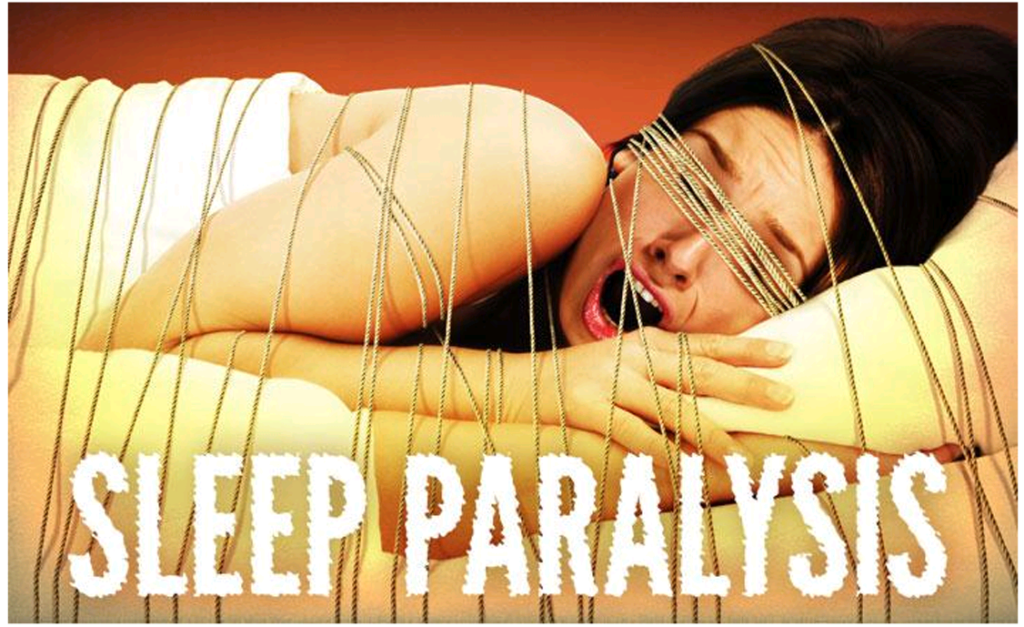INTRODUCTION
Sleep may be defined as a periodic state of rest accompanied by varying degrees of unconsciousness and relative inactivity (Psora/ Syphilis).
Sleep paralysis is a condition in which, upon waking, a person is aware of the surroundings but is unable to move.
SLEEP-WAKE CYCLE
The sleep-wake cycle varies in relation to the age and gender of the individual. Women past age 35 tend to sleep more than men.
On an average- Newborn-20 hr each day, Child- 10 hr each day, Adult- 7 hr each day, Elderly- 6.5 hr each day
There is great individual variation in the amount and depth of sleep.
STAGES OF SLEEP
Sleep has been found to have two states-
NON RAPID EYE MOVEMENTS
This is also called NREM or synchronized sleep and involves four stages.
Stage 1- Eye movements are slow, EEG shows low brain wave activity.
Stage 2- EEG activity is increased, with the appearance of spikes called K complexes
Stage 3- Eye movement ceases; wave frequency is reduced and amplitude increased.
Stage 4- EEG shows more delta activity.
RAPID EYE MOVEMENTS
This also called REM or dreaming sleep.
NREM and REM sleep alternate during the night; each cycle requires 90 to 100 min. NREM sleep composes approx. 75% of the sleep cycle and REM sleep approx. 25%, with variations among individuals.
Persons deprived of sleep for several days or more become irritable, fatigued, unable to concentrate, and usually disoriented (Psora/ Causa occasionalis). Performance of mental and physical tasks deteriorates. Some individuals experience paranoid thoughts and auditory, visual, and tactile illusions or hallucinations (Psora).
Deprivation of REM sleep may cause anxiety, overeating, and hypersexuality (Psora/ Pseudopsora/ Sycosis). The effects of sleep deprivation are reversed when the normal sleepwake cycle is resumed.
PHYSIOLOGICAL CHANGES DURING SLEEP
IN GENERAL
- Body temperature falls (Psora/ Syphilis)
- Secretion of urine decreases (Psora/ Syphilis)
- Increased secretion of growth hormone during the first 2 hr of sleep (Psora/ Sycosis)
- Surges of adrenocorticotropic hormone (ACTH) and cortisol secretion occur in the last half of the sleep period (Psora/ Sycosis)
- Luteinizing hormone secretion is increased during sleep in pubescent boys and girls (Psora/ Sycosis)
- Prolactin secretion is increased in men and women, esp. immediately after the onset of sleep (Psora/ Sycosis)
- Hand waving, arm swinging, laughing, and flatus occur during normal sleep (Psora)
- Snoring (Psora/ Sycosis/ Pseudopsora) may be clinically insignificant but, when accompanied by apnea, can be harmful.
IN NREM SLEEP
Heart rate and respiration become slower and more regular (Psora/ Syphilis)
IN REM SLEEP
- Heart rate and respiration become more rapid and less regular (Psora/ Sycosis)
- Blood flow to the brain is increased (Psora/ Sycosis)
- Breathing is more irregular (Psora/ Pseudopsora)
- Heart rate and blood pressure vary (Psora)
- Cerebral blood flow and metabolic rate increase (Psora/ Sycosis)
- Penile erections may occur (Psora)
The consequences of loss of sleep may include- fatigue, loss of concentration, or difficulties in coping or job performance (Psora/ Causa occasionalis). Most people feel and perform best with 6 to 8 hours of sleep each night.
Sleep paralysis is a commonly experienced condition during sleep.
DEFINITION
Sleep paralysis is a temporary, transitional state between wakefulness and sleep, experience by a person, either during falling asleep or awakening, with failure to move, speak or react associated with anxiety and intense fear, characterized by muscle atonia. (Psora)
TYPES
HYPNAGOGIC SLEEP PARALYSIS – It occurs during falling asleep when the body slowly relaxes. Now the person is subjectively awake and engaged in a mental struggle to move and to cry, but appears to be sleeping and sometimes dreaming. (Psora)
HYPNOPOMPIC SLEEP PARALYSIS– During sleep, body alternates between REM and NREM. The muscles are totally relaxed during REM sleep. If the person becomes aware before the REM cycle has finished, he may feel unable to move or speak. (Psora)
PATHOPHYSIOLOGY
Sleep paralysis occurs when person becomes aware during REM sleep and recognizes muscular atonia. This physiologic phenomenon occurs 4-6 times every night. Usually, the person are unaware of this state. Sleep paralysis is a dissociated state and is composed of two different states- REM sleep and waking, the latter being prominent part in contrast to normal REM sleep. Patients are aware of themselves and of their surroundings. REM sleep mental activity, however, may coexist with the above mentioned waking consciousness. The characteristic formal aspects of hallucinations associated with sleep paralysis e.g. the incubus, succubus, intruder, etc. correspond to characteristic aspects of physiological brain activation during REM sleep. (Psora)
CAUSES
- More common in teenagers and young adults
- Sleep deprivation (Psora/ Syphilis)
- Irregular sleeping patterns (Psora/ Syphilis/ Sycosis)
- Narcolepsy – some people with narcolepsy, a condition characterized by an extreme tendency to fall asleep whenever in relaxing surroundings may also have sleep paralysis. (Psora/ Syphilis)
- Family history
SIGN AND SYMPTOMS
- The inability to move the body when falling asleep or immediately upon waking up; lasting for seconds or several minutes.
- Consciously wakefulness.
- Unable to speak.
- Hallucinations and sensations of a frightening nature- incubus, succubus, intruder, humanoid, shadow man, demon, or other non-human being with murderous intentions.
- Night mares- Feeling pressure on the chest, bed moving, door opening or shuffling footsteps.
- Unable to be sure what was real and what was a dream, in spite of remembering clearly the details of the sleep paralysis event.
- Difficulty in breathing
- Feeling as if about to die
- Diaphoresis
- Headache, muscle pains and paranoia.
RISK FACTORS
Insomnia and sleep deprivation, stress, overuse of stimulants, physical fatigue and medications used to treat ADHD.
DIAGNOSIS
Symptomatic
TREATMENT
The symptoms of sleep paralysis can be minimized with good sleeping habits such as- Adequate sleep, Regular exercise, Stress reduction, Regular and consistent sleep schedule.
HOMOEOPATHIC REMEDIES SLEEP –
WAKING – paralyzed feeling, with etc… acon. caps. chin. ferr-i. kreos. meny. mill. nat-c. phos. plat. syph.
HOMOEOPATHIC THERAPEUTICS
SYPHYLINUM
EYE – PARALYSIS – Lids, of – Upper – sleepy; patient seems
PLATINA
EXTREMITIES – PARALYSIS – Hands – sensation of – sleep agg.; during
EXTREMITIES – PARALYSIS – Upper limbs – sensation of – sleep agg.; during
Arms – PARALYSIS, sensation of – sleep, during
Hands – PARALYSIS, sensation, hands – sleep, during
MILLIFOLIUM
EXTREMITIES – PARALYSIS – Upper limbs – sleep agg.; during
Arms – PARALYSIS, arms – sleep, during
CAPSICUM
EXTREMITIES – STIFFNESS – Joints – paralytic on rising from sleep
CHINA
Joints – STIFFNESS, joints – paralytic on rising from sleep
EXTREMITIES – STIFFNESS – Joints – paralytic on rising from sleep
MENYANTHES
Sleep – YAWNING, general – paralysis, of palate, with
SLEEP – Yawning – palate, paralysis of
ACONITE
SLEEP – WAKING – paralyzed feeling, with
FERRUM IOD
SLEEP – WAKING – paralyzed feeling, with
KREOSOTE
SLEEP – WAKING – paralyzed feeling, with
NATRUM CARB
SLEEP – WAKING – paralyzed feeling, with
PHOSPHORUS
SLEEP – WAKING – paralyzed feeling, with
BIBLIOGRAPHY
- Changes in the Cardiorespiratory System During Sleep Fishman’s Pulmonary Diseases and Disorders
- Chapter 14. Electrical Activity of the Brain, Sleep—Wake States, & Circadian Rhythms Ganong’s Review of Medical Physiology, 24e
- Chapter 166. Acute Peripheral Neurologic Lesions > Tick Paralysis Tintinalli’s Emergency Medicine … Tick paralysis, also known as tick toxicosis, is an uncommon disease. Multiple tick species can…
- Chapter 19. Sleep and Its Abnormalities > Clinical Features Adams & Victor’s Principles of Neurology, 10e … of life. Narcolepsy is usually the first symptom, less often cataplexy, and rarely sleep paralysis…
- Chapter 19. Sleep and Its Abnormalities > Narcolepsy and Cataplexy Adams & Victor’s Principles of Neurology, 10e … attacks and the temporary paralysis of the somatic musculature during bouts of laughter, anger, and other…
- Chapter 19. Sleep and Its Abnormalities > Physiology of Sleep and Sleep–Wake Mechanisms Adams & Victor’s Principles of Neurology, 10e … Sleep represents one of the basic 24-h (circadian) rhythms, traceable through all mammalian, avian…
- Chapter 19. Sleep and Its Abnormalities > Sleep Palsies and Acroparesthesias Adams & Victor’s Principles of Neurology, 10e … result in a sensory and motor paralysis—sometimes referred to as sleep or pressure palsy . Usually…
- Chapter 242. Sleep Apnea and Obesity Hypoventilation Syndrome Principles and Practice of Hospital Medicine
- Chapter 254. Head Trauma in Adults and Children > Paralysis Tintinalli’s Emergency Medicine … they are short acting. Extended paralysis is no longer recommended as a first-tier treatment for elevations…
- Chapter 26. Disorders of the Autonomic Nervous System, Respiration, and Swallowing > Acute Autonomic Paralysis (Dysautonomic Polyneuropathy; Pure Pandysautonomia) Adams & Victor’s Principles of Neurology, 10e …, orthostatic hypotension, paralysis of pupillary reflexes, loss of lacrimation and salivation, erectile…
- Chapter 27. Sleep Disorders > Sleep & Psychiatric Disorders (Sleep Disorders Related to Another Mental Disorder) CURRENT Diagnosis & Treatment: Psychiatry, 2e
- Chapter 27. Sleep Disorders CURRENT Diagnosis & Treatment: Psychiatry, 2e
- Chapter 3. Motor Paralysis Adams & Victor’s Principles of Neurology, 10e
- Chapter 41. Sleep Disorders > Classification of Sleep & Sleep Disorders CURRENT Diagnosis & Treatment in Otolaryngology—Head & Neck Surgery, 3e
- Chapter 41. Sleep Disorders > Classification of Sleep & Sleep Disorders CURRENT Diagnosis & Treatment in Otolaryngology—Head & Neck Surgery, 3e
- Chapter 45. Developmental Disorders of Attachment, Feeding, Elimination, & Sleeping > Sleep Apnea (Breathing-Related Sleep Disorder) CURRENT Diagnosis & Treatment: Psychiatry, 2e
- Chapter 55. Sleep Disorders Hazzard’s Geriatric Medicine and Gerontology, 6e
- Chapter 74. Epidemiology and Mechanisms Linking Sleep-Disordered Breathing and Cardiac Disease Hurst’s The Heart, 13e
- Chapter 94. Insomnia: Assessment and Management of Sleep Disorders Principles and Practice of Hospital Medicine
- Circadian Rhythms and Sleep Biology Fishman’s Pulmonary Diseases and Disorders
- Encyclopedia Homoeopathica
- Endocrine Disorders > 6. Thyrotoxic hypokalemic periodic paralysis Current Medical Diagnosis & Treatment 2015 … Sudden symmetric flaccid paralysis, along with hypokalemia and hypophosphatemia can occur…
- Neurologic Causes of Weakness and Paralysis Harrison’s Principles of Internal Medicine
- Sleep > OVERVIEW OF SLEEP ARCHITECTURE AND POTENTIAL DISRUPTERS TO SLEEP Principles of Critical Care, 4e … TABLE 23-3 Sleep Abnormalities in Critically Ill Patients Who Are Not Deeply Sedated…
- Sleep Apnea Syndromes: Central and Obstructive Fishman’s Pulmonary Diseases and Disorders
- Sleep Disorders > Narcolepsy Behavioral Medicine: A Guide for Clinical Practice, 4e …, and less frequently, sleep paralysis and hypnagogic hallucinations. It occurs in approximately 1 in 2000…
- Sleep Disorders Current Diagnosis & Treatment: Geriatrics
- Sleep Principles of Critical Care, 4e
- Sleep-Related Hypoventilation Syndromes Fishman’s Pulmonary Diseases and Disorders The Chest: Chest Wall, Pulmonary, and Cardiovascular Systems; The Breasts > Sleep-disordered breathing—obstructive and central sleep apnea DeGowin’s Diagnostic Examination, 10e …
- Sleep disordered breathing results from either mechanical obstruction by redundant, lax…
- Radar 10 9
ABOUT AUTHOR
Dr. Rajneesh Kumar Sharma M.D. (Homoeopathy)

Dr. Swati Vishnoi B.H.M.S.

